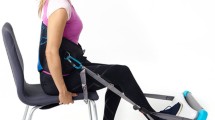Abstract
The Functional Reach (FR) Test is commonly used in the clinical practice to identify elderly subjects at risk of recurrent falls. This study was designed to provide a useful tool for supporting the assessment of fall risk in diabetic neuropathic (DN) subjects: a non-invasive analysis of muscle activation patterns involved in the FR test using wireless surface electromyography (sEMG). Kinematic analysis was also performed to support results achieved by sEMG technique. A population of diabetic non-neuropathic subjects was considered as control group (CTRL). Kinematics was acquired by a 6-camera Elite optoelectronic system and passive markers were placed according to Davis protocol, with an additional marker placed on dominant wrist. sEMG analysis of Sternocleidomastoideus, Rectus Abdominis, Erectores Spinae at L4 level (L4), Rectus Femoris, Hamstrings (Ham), Tibialis Anterior (TA) and Soleus (Sol) was performed. No significant differences (p-value for evaluation of statistical significance was < 0.05) were detected between groups in the computed kinematics parameters. sEMG analysis shows that in CTRL subjects, TA was identified as the first motor, since it activates before the start of FR movement; its action can be attributed to the anticipatory muscular activity necessary to initiate the body forward displacement. Sol and Ham, followed by L4, act mainly as tonic muscles, opposing the movement and preventing falls. Compared to CTRL group, DN subjects show an anticipatory recruitment of TA. The earlier activation of TA in DN group suggests that this anticipation could be a predictor of a greater propensity of the DN subjects to fall compared to non-neuropathic diabetic subjects.
Access this chapter
Tax calculation will be finalised at checkout
Purchases are for personal use only
Similar content being viewed by others
References
Simoneau GG, Ulbrecht JS, Derr JA et al (1994) Postural instability in patients with diabetic sensory neuropathy. Diab Care 17:1411–1421
Fioretti S, Scocco M, Ladislao L et al (2010) Identification of peripheral neuropathy in type-2 diabetic subjects by static posturography and linear discriminant analysis. Gait Posture 32:317–320
Bloem BR, Allum JH, Carpenter MG et al (2000) Is lower leg proprioception essential for triggering human automatic postural responses? Exp Brain Res 130:375–391
Inglis JT, Horak FB, Shupert CL et al (1994) The importance of somatosensory information in triggering and scaling automatic postural responses in humans. Exp Brain Res 101:159–164
Duncan PW, Weiner DK, Chandler J et al (1990) Functional reach: a new clinical measure of balance. J Gerontol 45:M192–M197
Duncan PW, Studenski S, Chandler J et al (1992) Functional reach: predictive validity in a sample of elderly male veterans. J Gerontol 47:M93–M98
Maranesi E, Ghetti G, Rabini RA et al (2014) Functional reach test: movement strategies in diabetic subjects. Gait Posture 39:501–505
Di Nardo F, Mengarelli A, Maranesi E et al (2015) Assessment of the ankle muscle co-contraction during normal gait: A surface electromyography study, J Electromyogr Kinesiol 25(2):347–354
Di Nardo F, Ghetti G, Fioretti S (2013) Assessment of the activation modalities of gastrocnemius lateralis and tibialis anterior during gait: a statistical analysis. J Electromyogr Kinesiol 23(6):1428–1433
Di Nardo F, Fioretti S (2013) Statistical analysis of surface electromyographic signal for the assessment of rectus femoris modalities of activation during gait. J Electromyogr Kinesiol 23(1):56–61
Di Nardo F, Fioretti S (2014) Emg-based analysis of treadmill and ground walking in distal leg muscles. IFMBE Proc 41:611–614. doi:10.1007/978-3-319-00846-2_151
Hubble RP, Naughton GA, Silburn PA (2014) Trunk muscle exercises as a means of improving postural stability in people with Parkinson’s disease: a protocol for a randomised controlled trial. BMJ Open 4
Lee D, Lee S, Park J et al (2013) The effect of fixed ankle and knee joints on postural stability and muscle activity. J Phys Ther Sci 25:33–36
Zhou H, Hu H (2008) Human motion tracking for rehabilitation—A survey. Biomed Signal Process Control 3:1–18
Kozak K, Ashton-Miller JA, Alexander NB (2003) The effect of age and movement speed on maximum forward reach from an elevated surface: a study in healthy woman. Clin Biomech 18(3):190–196
Davis RB, Ounpuu S, Dennis T et al (1991) A gait analysis data collection and reduction technique. Hum Mov Sci 10:575–587
Freriks B, Hermens HJ, Disselhorst-Klug C (1999) The recommendations for sensors and sensor placement procedures for surface electromyography. In: Hermens HJ, Freriks B, Merletti R, Stegeman D, Bok J, Rau G et al (eds) European recommendations for surface electromyography. Results of the SENIAM project. Enschede: Roessingh Research and Development
Maranesi E, Fioretti S, Ghetti GG et al (2016) The surface electromyographic evaluation of the functional reach in elderly subjects. J Electromyogr Kinesiol 26:102–110
De Luca CJ (1997) The use of electromyography in biomechanics. J Appl Biomech 13(2):135–163
Maranesi E, Di Nardo F, Rabini RA et al (2016) Muscle activation patterns related to diabetic neuropathy in elderly subjects: a functional reach test study. Clin Biomech 32:236–240
Author information
Authors and Affiliations
Corresponding author
Editor information
Editors and Affiliations
Rights and permissions
Copyright information
© 2016 Springer International Publishing Switzerland
About this paper
Cite this paper
Maranesi, E. et al. (2016). The Wireless Surface Electromyographic Technique for Supporting the Assessment of Fall Risk in Diabetic Neuropathic Patients. In: Conti, M., Martínez Madrid, N., Seepold, R., Orcioni, S. (eds) Mobile Networks for Biometric Data Analysis. Lecture Notes in Electrical Engineering, vol 392. Springer, Cham. https://doi.org/10.1007/978-3-319-39700-9_22
Download citation
DOI: https://doi.org/10.1007/978-3-319-39700-9_22
Published:
Publisher Name: Springer, Cham
Print ISBN: 978-3-319-39698-9
Online ISBN: 978-3-319-39700-9
eBook Packages: EngineeringEngineering (R0)




